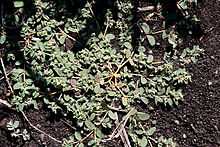Euphorbia maculata
From Wikipedia, the free encyclopedia
| Euphorbia maculata | |
|---|---|
 | |
| Scientific classification | |
| Kingdom: | Plantae |
| (unranked): | Angiosperms |
| (unranked): | Eudicots |
| (unranked): | Rosids |
| Order: | Malpighiales |
| Family: | Euphorbiaceae |
| Genus: | Euphorbia |
| Species: | E. maculata |
| Binomial name | |
| Euphorbia maculata L. | |
Euphorbia maculata (syn. Chamaesyce maculata (L.) Small, variously called spotted spurge or prostrate spurge), is an annual plant in the family Euphorbiaceae, native to North America.
It is a variably prostrate to erect plant, with stems growing along the ground up to 45 cm long, but only reaching up to 30 cm tall. The leaves are oval, up to 3 cm long, and arranged in opposite pairs. The flowers are very small, with four white petals. It grows in sunny locations and a variety of soils, and is frequently found as a weed in gardens. The sap of this plant is a skin irritant and will cause a rash similar to Poison Ivy. Use gloves when pulling this weed.
References
- Germplasm Resources Information Network: Chamaesyce maculata
- Missouriplants: Euphorbia maculata
| Wikibooks' A Wikimanual of Gardening has more about this subject: |
| Wikimedia Commons has media related to Euphorbia maculata. |
This article is issued from Wikipedia. The text is available under the Creative Commons Attribution/Share Alike; additional terms may apply for the media files.